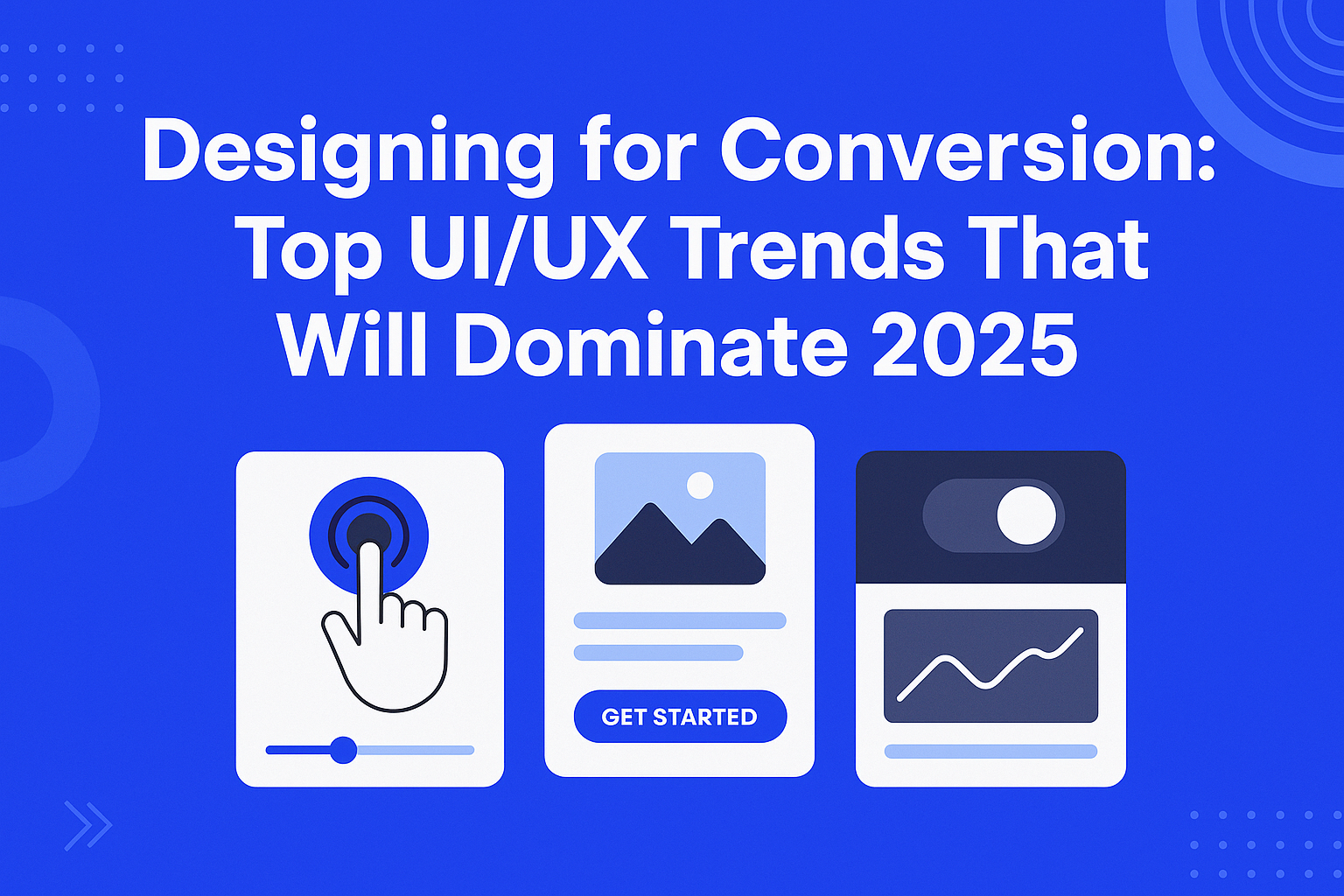Designing for Conversion: Top UI/UX Trends That Will Dominate 2025
In today’s digital world, looks aren’t everything. Sure, a clean, modern interface grabs attention—but that’s just step one. What really counts is what happens next: Does your design actually convert? Does it move people—get them to click, sign up, buy, or stick around?
We work on conversion-driven UI/UX design every day, and one thing’s become clear: design isn’t just about making things pretty anymore. It’s about making them perform.
As we head into 2025, user expectations are rising, technology is evolving fast, and businesses are under pressure to turn attention into action. So the big question isn’t “Does it look good?”—it’s “Does it work?”
Let’s walk through the Top UI/UX trends that we believe will define 2025—and help you design experiences that don’t just impress, but convert.
1. Hyper-Personalized User Journeys
Personalization has moved beyond just using a user’s name in a greeting. In 2025, it’s about building entire user journeys based on behavior, preferences, and even device usage.
What’s changing:
- Real-time content adjustments based on user interactions.
- Smart onboarding flows tailored to first-time vs. returning users.
- Product recommendations powered by AI segmentation.
📌 Why it matters: The more relevant the experience, the higher the chances of conversion. Users today expect apps and websites to “know” what they want next—and deliver it without friction.
2. Microinteractions That Guide Behavior
Subtle, meaningful animations and responses—known as microinteractions—are playing a big role in keeping users engaged and nudging them toward taking action.
How brands are using them:
- Haptic feedback for taps on mobile.
- Animated confirmation after form submissions.
- Progress indicators during multi-step actions (like checkout).
📌 Design tip: Microinteractions reduce cognitive load and help users understand if they’re on the right track—resulting in smoother, more confident conversions.
3. Emotion-Led & Neurodesign Principles
UX design is getting emotional—and that’s a good thing. Using principles from psychology and neuroscience, designers are crafting interfaces that tap into users’ emotional responses.
Expect to see:
- Color palettes that influence decision-making (e.g., green for trust, red for urgency).
- Visual storytelling layouts that create connection.
- Gamification elements that reward user action and increase retention.
📌 Why this works: Emotionally engaged users are more likely to act—and return.
4. Dark Mode by Default (But Smarter)
Dark mode isn’t just a trend—it’s a preference. But in 2025, it’s becoming more intelligent and context-aware.
What’s new:
- Auto-switching based on ambient lighting or user schedule.
- Accessibility-focused contrast enhancements.
- Layered visual depth to reduce eye strain during long sessions.
📌 Impact on conversion: Comfortable users stay longer. Longer sessions often lead to higher conversions.
5. Predictive UX with AI Integration
AI is no longer just behind the scenes. It’s directly shaping UI/UX by predicting what users need—before they even ask.
Real-world applications:
- Smart search that adjusts results based on user history.
- Autofilled forms and suggested actions based on previous behavior.
- Chatbots that intelligently escalate to humans only when needed.
📌 Bottom line: Predictive UX cuts decision fatigue and accelerates the path to conversion.
6. Design Systems That Scale—Without Losing Soul
2025 is all about consistency and speed, especially for growing products. Modular design systems are enabling teams to deliver faster, but without sacrificing creativity.
Trending approaches:
- Token-based theming for instant global updates.
- Component libraries with built-in conversion best practices.
- Figma-to-code workflows that minimize design-to-dev gaps.
📌 Pro move: Build your design system around the most used, highest-converting components—like call-to-action buttons, input forms, and banners.
7. Lightning-Fast Experiences = Higher Conversions
Speed has always mattered, but now it’s non-negotiable. With Google’s Core Web Vitals tied to both SEO and user experience, design decisions must prioritize load performance.
What designers are focusing on:
- Minimizing heavy assets (bye-bye 5MB images).
- Using SVGs for crisp, lightweight visuals.
- Prioritizing content loading based on viewport and user behavior.
📌 Why this matters: Every extra second a page takes to load can cost you conversions. Literally.
8. UX Writing That Converts, Not Confuses
Design and copy go hand-in-hand. In 2025, UX writing is evolving into a key conversion lever—clarity and tone are everything.
Winning techniques:
- Button copy that focuses on value (“Start My Free Trial” > “Submit”).
- Microcopy that builds trust (“We’ll never share your email”).
- FOMO and urgency phrases for limited-time offers.
📌 Quick tip: Run A/B tests on CTA copy—it can boost conversions without touching the design.
9. Scroll-Activated Visual Hierarchies
With vertical screens and endless feeds, scroll-based storytelling is being reimagined to convert, not just impress.
New patterns:
- Sticky headers with evolving calls to action.
- Animated stats or offers that appear only at key scroll points.
- Scroll-depth tracking to trigger form modals or freebie offers.
📌 Keep in mind: Motion is great—until it becomes distraction. Use it with intent.
10. Simplified, Trust-Boosted Checkouts
The end of your funnel should feel like a natural next step—not a final exam. The checkout process is being stripped of distractions and optimized for completion.
High-converting checkout designs include:
- Clean, minimal layouts with progress bars.
- Inline validation and clear error messages.
- Built-in trust signals (secure payment badges, testimonials).
📌 Best practice: Offer single-click payment options and allow guest checkout. Fewer steps = more purchases.
Final Thoughts: Designing With Purpose
Designing for conversion in 2025 means thinking beyond the visual surface. Every interaction, every word, every pixel should serve a purpose: to guide users toward a meaningful action.
It’s not about overwhelming users with flashy design—it’s about crafting experiences that are human, helpful, and high-performing.
So whether you’re redesigning a product page or building a new onboarding flow, ask yourself:
“Is this helping the user say ‘yes’?”
If the answer is yes—you’re on the right path.

